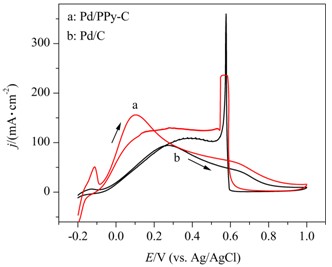[1] Uhm, S.; Lee, H. J.; Lee, J. PCCP 2009, 11, 9326. 
[2] Ma, Y. J.; Yang, M. X.; Wang, W. F.; Zhou, M.; Liu, J.; Li, T. T.; Chen, H. Acta Chim. Sinica 2011, 69, 262. (马永钧, 杨梅霞, 王伟峰, 周敏, 刘婧, 李婷婷, 陈慧, 化学学报, 2011, 69, 262.)
[3] Serov, A.; Kwak, C. Appl. Catal. B: Environ. 2009, 91, 1. 
[4] Antolini, E. Energy Environ. Sci. 2009, 2, 915. 
[5] Liu, Y.; Wang, L. W.; Wang, G.; Deng, C.; Wu, B.; Gao, Y. J. Phys. Chem. C 2010, 114, 21417.
[6] Pan, Y. H.; Zhang, R. M.; Blair, S. L. Electrochem. Solid-State Lett. 2009, 12, B23. 
[7] Zhang, S. X.; Qing, M.; Zhang, H.; Tian, Y. N. Electrochem. Commun. 2009, 11, 2249. 
[8] Zhang, L.; Li, F. Electrochim. Acta 2010, 55, 6695. 
[9] Zhao, Y. C.; Wang, F. Y.; Tian, J. N.; Yang, X. L.; Zhan, L. Electrochim. Acta 2010, 55, 8998. 
[10] Sun, Z. P.; Zhang, X. G.; Tong, H.; Liang, Y. Y.; Li, H. L. J. Colloid Interface Sci. 2009, 337, 614. 
[11] Ji, X. L.; Lee, K. T.; Holden, R.; Zhang, L.; Zhang, J. J.; Botton, G. A.; Couillard, M.; Nazar, L. F. Nat. Chem. 2010, 2, 286. 
[12] Tu, D. D.; Wu, B.; Wang, B. X.; Deng, C.; Gao, Y. Appl. Catal. B: Environ. 2011, 103, 163. 
[13] Liu, Z. L.; Zhang, X. H.; Hong, L. Electrochem. Commun. 2009, 11, 925. 
[14] Dhaoui, W.; Hasik, M.; Djurado, D.; Bernasik, A.; Pron, A. Synth. Met. 2010, 160, 2546. 
[15] Liao, C.; Wei, Z. D.; Chen, S. G.; Li, L.; Ji, M. B.; Tan, Y.; Liao, M. J. J. Phys. Chem. C 2009, 113, 5705. 
[16] Wang, Z.; Zhu, Z. Z.; Li, H. L. Acta Chim. Sinica 2007, 65, 1149. (王喆, 朱赞赞, 力虎林, 化学学报, 2007, 65, 1149.)
[17] Selvaraj, V.; Alagar, M.; Kumar, K. S. Appl. Catal. B: Environ. 2007, 75, 129. 
[18] Ding, K. Q.; Jia, H. T.; Wei, S. Y.; Guo, Z. H. Ind. Eng. Chem. Res. 2011, 50, 7077. 
[19] Qu, B.; Xu, Y. T.; Lin, S. J.; Zheng, Y. F.; Dai, L. Z. Synth. Met. 2010, 160, 732. 
[20] Yang, S.; Shen, C.; Liang, Y.; Tong, H.; He, W.; Shi, X.; Zhang, X.; Gao, H.-J. Nanoscale 2011, 3, 3277. 
[21] Ding, K.; Jia, H.; Wei, S.; Guo, Z. Ind. Eng. Chem. Res. 2011, 50, 7077. 
[22] Radmilovic, V.; Gasteiger, H. A.; Ross, P. N. J. Catal. 1995, 154, 98. 
[23] Zhou, Y.; Liu, J. G.; Ye, J. L.; Zou, Z. G.; Ye, J. H.; Gu, J.; Yu, T.; Yang, A. D. Electrochim. Acta 2010, 55, 5024. Yu, X. W.; Pickup, P. G. Electrochem. Commun. 2009, 11, 2012. 
|
